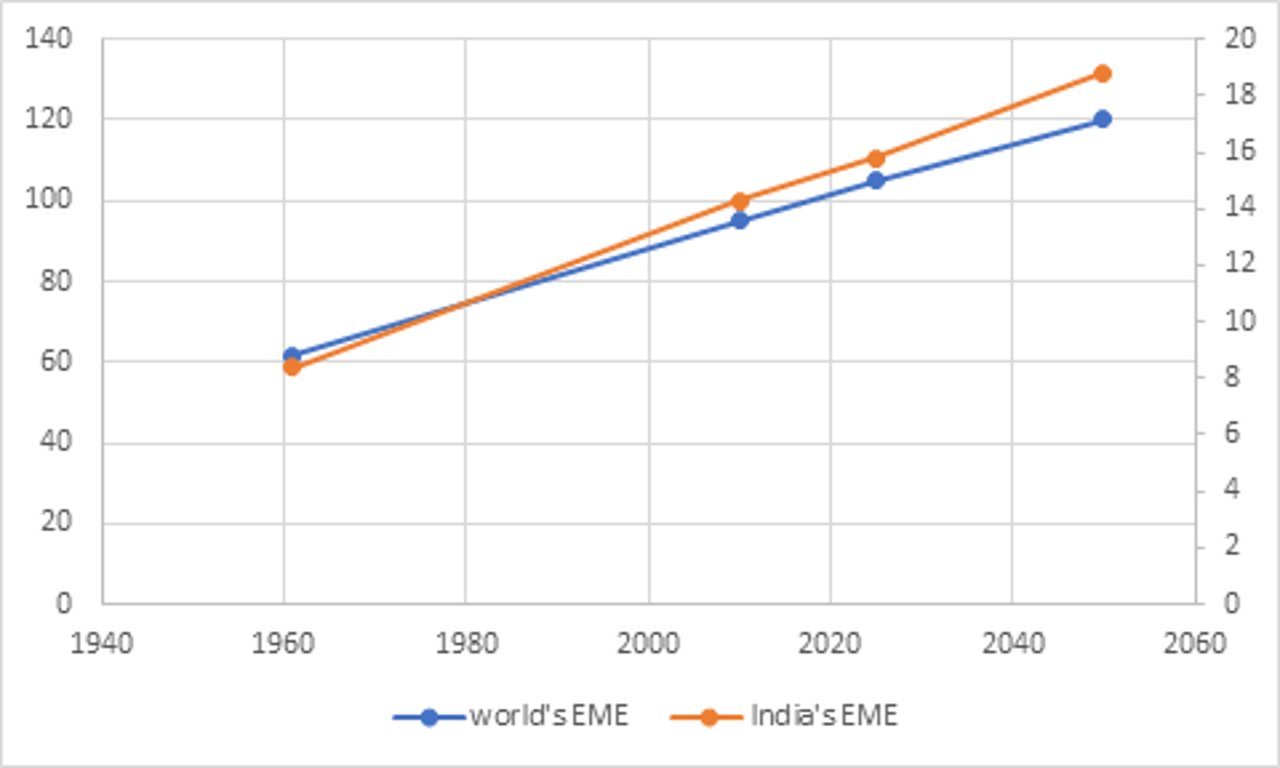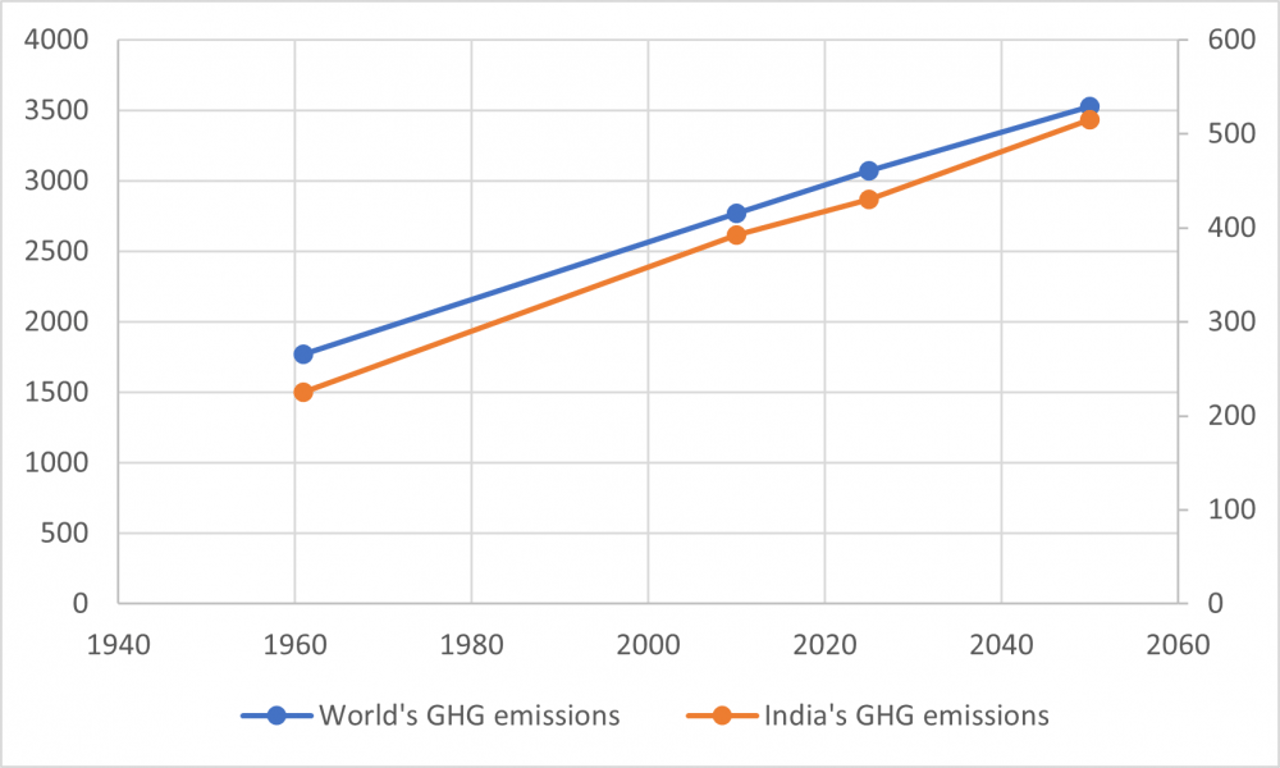
Planet on your plate- The True Impact of Intensive Farming in India
Is climate change a hoax or a different story?
Some sceptics still believe that climate change is a hoax. But numbers tell a whole different story. Scientists are saying that climate change could become the reason for mass extinction. Compared to before 1900, the atmosphere is today 1.1 degrees hotter. Most scientists (95%) agree that it is because of human activity.
Climate change does not only mean a rise in the earth’s temperature. Sea level rise, alteration of weather cycles like flood and drought and many other things. The impact of climate change can be seen in various areas that our lives are connected to, such as water, food, energy, transportation, wildlife, agriculture, ecosystem and human health. (i)
Total enteric methane emissions from livestock population in India and in the world with trends and prediction
The West Bengal University of Animal and Fishery Sciences study estimated and predicted the trends of enteric methane emissions in the world and in India. It is increasing by an annual growth rate of 0.90× 109kg for the world and 1.10 ×109kg for India.
Measured and predicted greenhouse gas (kg*109) emissions from livestock in the world and India
The biggest contributors to rapidly growing greenhouse gas emissions
After China and USA, India ranks as the third highest emitter of greenhouse gases worldwide. The biggest contributors to rapidly growing emissions levels are cattle, rice fields and coal power stations(ii). Total worldwide GHG emissions (in CO2-equivalent) grew from 1769 million tonnes in 1961 to 2,771 million tonnes in 2010, with an annual growth rate of 0.92%, although India had a higher rate, i.e., 1.13%, than the rest of the world.
As we can clearly observe from the graph, GHG emissions from livestock are increasing exponentially; if nothing can be done that it will double in the year 2050 compared to 1961. While, for India, overall GHG emissions from livestock are predicted to reach 515 million tonnes per year in 2050, which is approximately 2.3 times more than in 1961. In the West Bengal University study (2014), livestock from India accounted for 14.1% of total world GHG emissions( iii)
Livestock accounts for about 18% of the global GHGs emissions, including methane emissions from enteric fermentation, N2O emissions from manure and fertilizer, and CO2 emissions from land-use change and agricultural energy use (FAO 2006). xvii Methane is 86 times more destructive than CO2 because it warms the planet by 86 times as much as CO2.(iv)
The Report- Planet on your plate!
We have just launched our “Planet on your plate” report, which focused on the impact of livestock systems on climate. It consists of livestock GHG emissions, the numbers of livestock and key recommendation to reduce Greenhouse gases.
It also lists the findings from our global report on the world’s four biggest factory farming hot spots: Brazil, China, the USA and the Netherlands (representing Europe). Across the four hot spots, annual consumption of chicken alone creates the same climate change impact as keeping 29 million cars on the road for a year.
Methane from animal manure is a significant component of the overall climate impact of pork production in intensive farms, accounting for 21% of emissions from pork for the Netherlands, 22% for the USA, and 24% for Brazil. Methane is a greenhouse gas with a high potential to warm our climate.v
Solution : To produce and consume less and better
The best way to substantially reduce climate change and environmental impacts from intensive farming systems are to produce and consume ‘less and better, meaning significant reductions overall and ensuring higher welfare animal production.
Governments should redirect subsidies and policy support to humane, sustainable, and plant-based food. Public procurement policies should reflect this shift. The intensive farming industry should commit to reducing animal products in their operations by at least 50% by 2040.
Conclusion: We are all part of the solution
When it comes to climate change or other environmental issues, we think of letting the government handle the issue or letting the other political party take action. No, if we are part of the problem, we must all be part of the solution.
Reference:
i https://www.noaa.gov/education/resource-collections/climate/climate-cha…
ii Chhabra, A. (2012, August 16). Greenhouse gas emissions from Indian livestock. SpringerLink. https://link.springer.com/article/10.1007/s10584-012-0556-8?error=cooki…
iii Greenhouse gas emissions from Indian livestock. (2012, August 16). SpringerLink. https://link.springer.com/article/10.1007/s10584-012-0556-8?error=cooki…
iv https://www.scientificamerican.com/article/how-bad-of-a-greenhouse-gas-…
v Statista. (2022, March 17). Export volume of beef and veal in India 2016-2022. https://www.statista.com/statistics/1181402/india-beef-and-veal-export/
Vikash Kumar works as a Research Intern for Animals in Farming at World Animal Protection India. Through his Dissertation “Antidiabetic Bioactive Peptides : Insilico approaches to study Antidiabetic Bioactive Peptides he made an attempt to develop an anti-diabetic peptide database by using machine learning techniques(SVM). Being an environmental enthusiast, he supported the ongoing global campaign Save Soil

